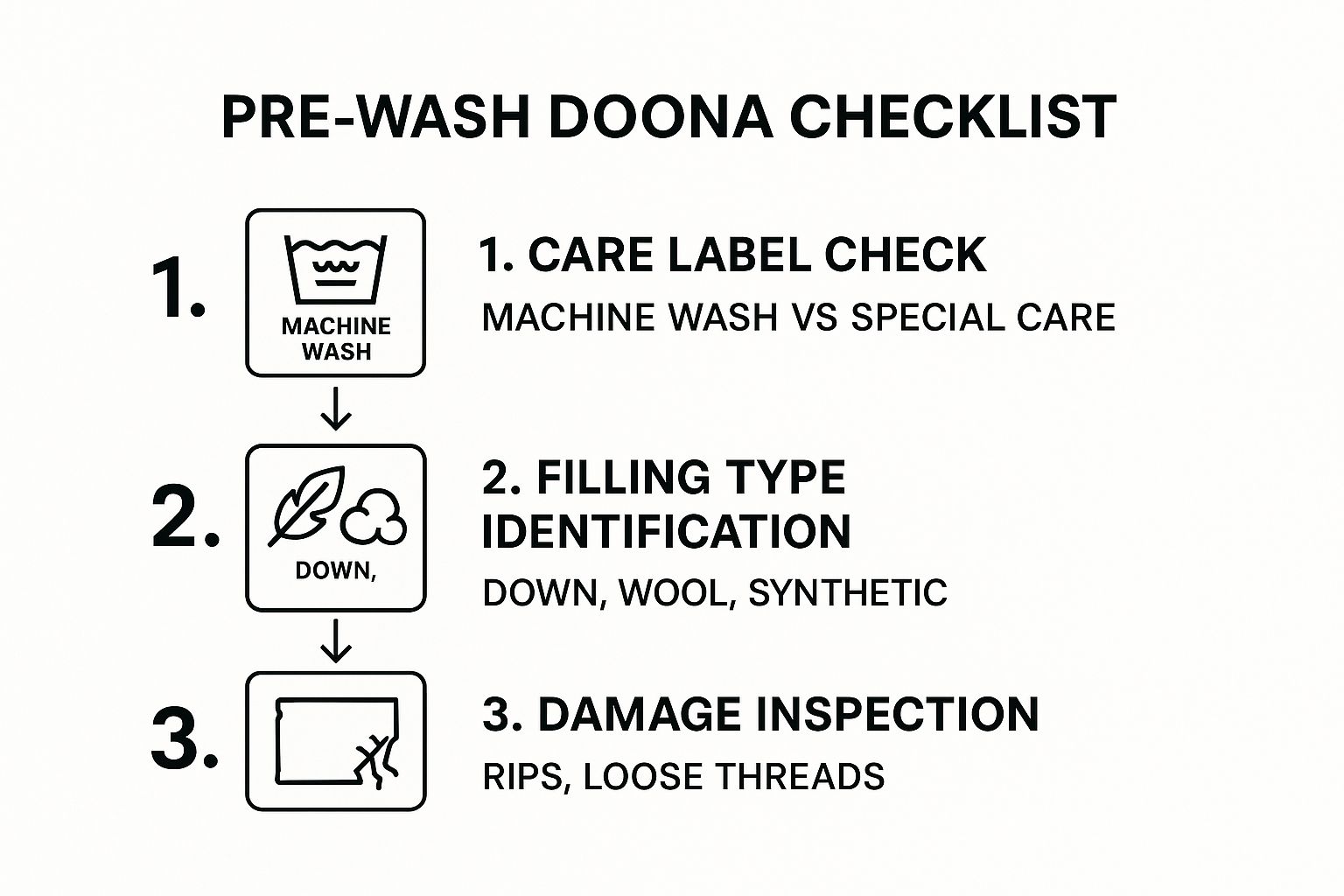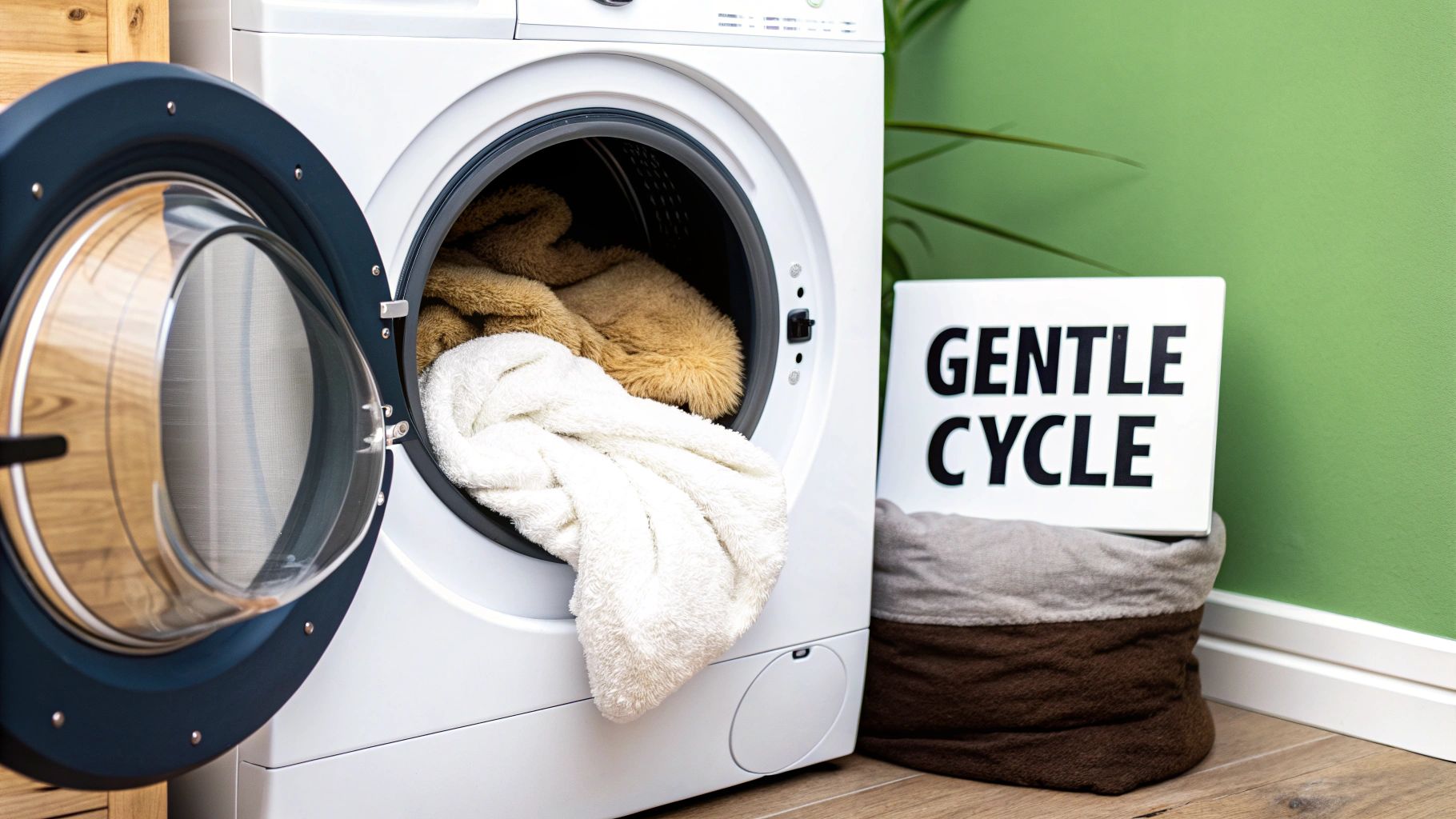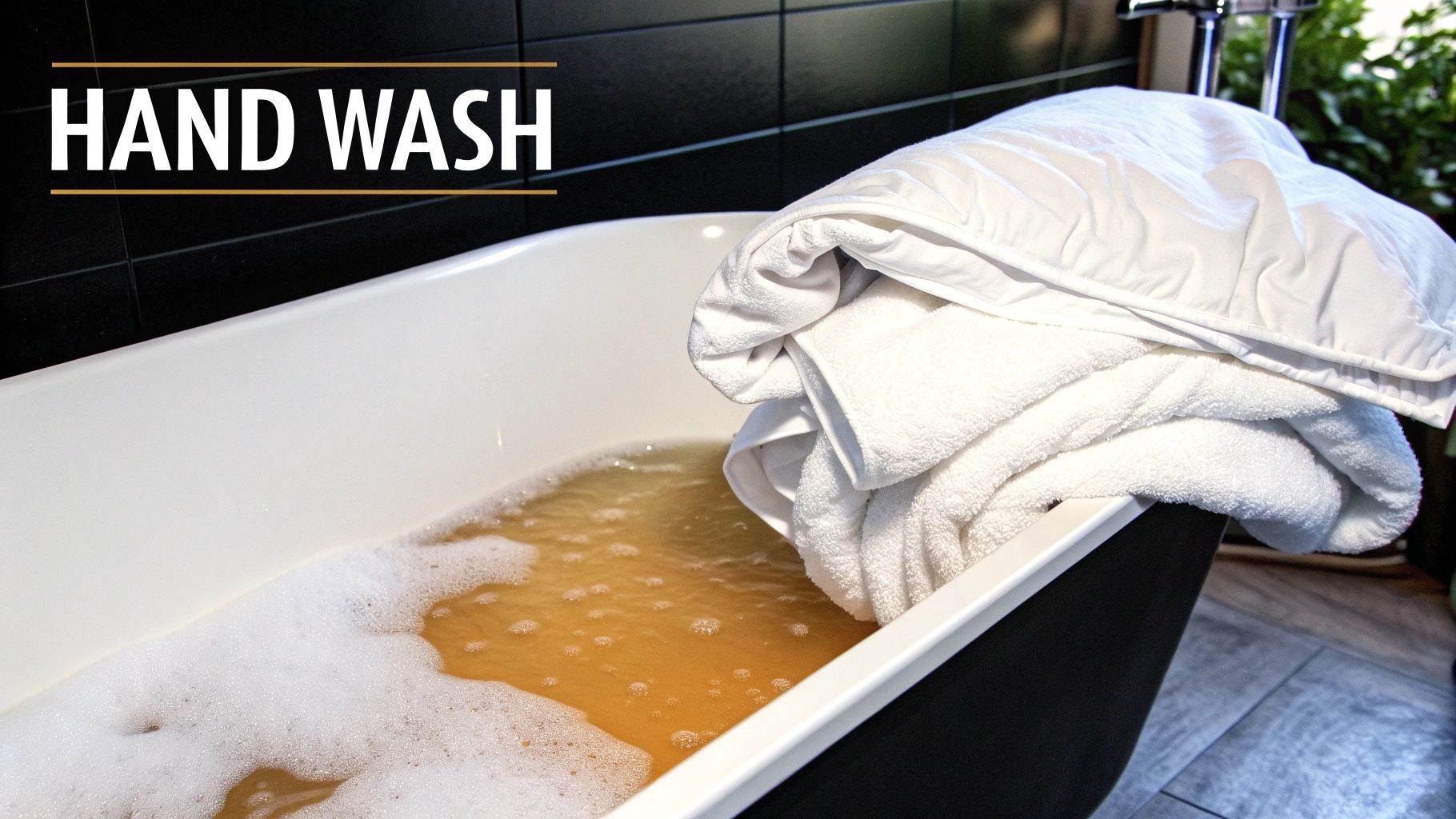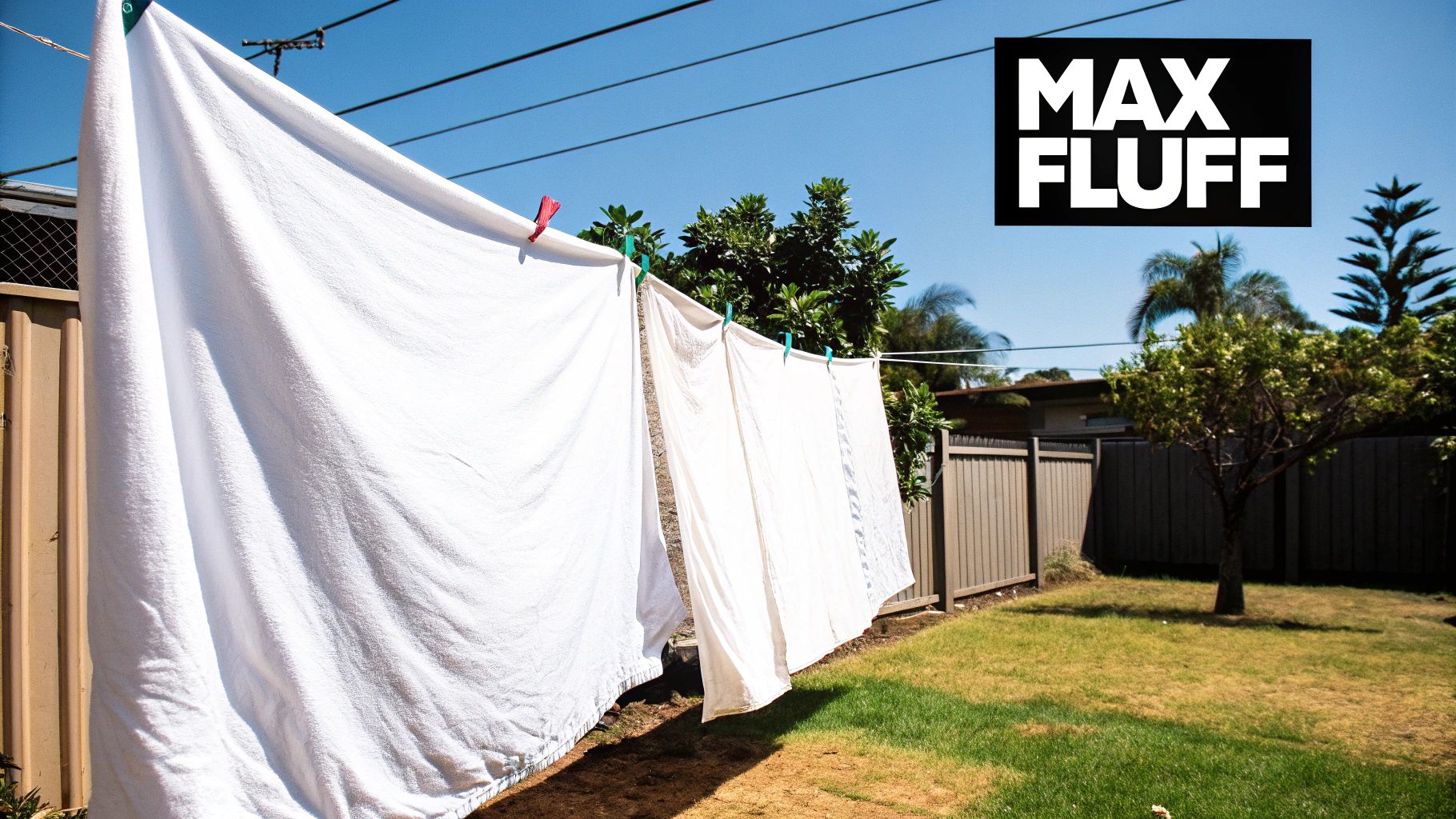Tossing a doona straight into the wash without a bit of prep is a recipe for a laundry disaster. I've seen it happen. The simple truth is that a few key checks before you start—like reading the care label and checking for rips—will save you a world of pain. This little bit of prep work is what ensures your doona comes out clean, fluffy, and ready for many more cosy nights.
Your Pre-Wash Doona Checklist
Before your doona gets anywhere near water, a quick but thorough once-over is the most important part of the whole process. Think of it as a pre-flight check for your bedding. Skipping this can turn a simple wash into a costly mistake, potentially clumping the filling or causing damage that can't be fixed.
This initial check isn't complicated and only takes a few minutes. It’s all about knowing what your doona is made of, what the manufacturer actually wants you to do, and making sure it's in good enough shape to handle a wash cycle.
Decode the Care Label
The first and most important piece of information is right there on the care tag. This little label is your instruction manual, telling you exactly what the manufacturer recommends. It will specify:
- Washing Method: Whether it’s machine washable, hand-wash only, or strictly needs professional dry cleaning.
- Water Temperature: The perfect temperature (usually cold or warm) to prevent the filling from shrinking or getting damaged.
- Drying Instructions: If you can pop it in the tumble dryer and, crucially, at what heat setting.
Ignoring these symbols is a massive gamble. A doona meant for dry cleaning could be completely ruined in a washing machine, and using hot water on a wool doona will almost certainly cause it to shrink and felt.
Identify the Filling Material
The filling dictates everything. Down, feathers, wool, cotton, and synthetic fibres like polyester all react differently to water, detergent, and the tumbling of a machine.
A delicate down doona, for example, needs a much gentler touch than a hardy polyester one. Knowing what's inside helps you pick the right detergent and the correct wash cycle. For those who prioritise a healthier home, exploring non-toxic upholstery cleaning methods can also give you some great ideas for choosing gentle, safe products for your bedding.
Inspect for Damage
Lay the doona flat on your bed and give it a quick look over. You're searching for any small rips in the fabric, loose stitching along the seams, or any spots that look a bit weak.
A vigorous wash cycle can easily turn a tiny hole into a huge tear, spilling filling all through your machine. Trust me, it’s much easier to stitch up a small tear beforehand than to deal with a blizzard of down or polyester fluff later. A secure doona cover also does a fantastic job of protecting it, which is just one of the reasons we explain in our guide on why a quilt cover is important.
This infographic breaks down the essential pre-wash doona checklist into three simple, sequential steps.

As you can see, starting with the care label is non-negotiable. It dictates every other decision you'll make to get your doona clean without any dramas.
Machine Washing Your Doona Like a Pro

Washing a big, bulky doona at home can feel a bit daunting, but it’s totally doable with the right setup. The trick is to give it plenty of room to move around so it gets properly clean without squashing the filling.
This is where a large, front-loading washing machine becomes your best mate.
Front-loaders gently tumble the doona, which is much kinder to the delicate fibres inside compared to a top-loader with a central agitator. That agitator can grab, twist, and tear the fabric, causing irreversible clumping.
If you only have a large-capacity top-loader without an agitator, you can still give it a go. Just be extra careful to make sure the doona is balanced in the drum.
Choosing The Right Machine Settings
Once the doona is in, picking the right settings is crucial for keeping it fluffy and intact. It can be tempting to hit the heavy-duty cycle, but trust me, gentle is the only way to go.
Here are the ideal settings to look for:
- Cycle: Always choose the delicate, gentle, or wool cycle. These settings are designed to minimise rough spinning and agitation, which protects the seams and filling.
- Water Temperature: Stick to cool or warm water (no hotter than 40°C). Hot water can shrink natural fillings like wool or cotton and may even damage synthetic fibres.
- Spin Speed: Set the spin speed to low or medium. A high-speed spin is the fastest way to compress the filling into dense, uncomfortable clumps.
These settings are pretty similar to what you'd use for other bulky bedding. Getting the hang of it is useful for all your cosy layers, like if you're learning how to care for your snuggle fleece comforter, helping everything last much longer.
The most common mistake I see is using a cycle that's too aggressive. A gentle wash might take longer, but it's the only way to make sure your doona comes out clean, fluffy, and undamaged.
Detergent Choices And The Tennis Ball Trick
The kind of detergent you use really matters here. Harsh chemicals can strip natural fibres like down and wool of their essential oils, making them brittle over time. Always go for a mild, liquid detergent, and only use about half of what you would for a normal load of clothes.
And this part is critical: skip the fabric softener. It leaves a film on the filling that builds up over time, reducing its fluffiness and ability to insulate.
Finally, here’s a game-changing tip to stop clumping and get a really even wash: toss two or three clean tennis balls or wool dryer balls into the drum with your doona. As the machine turns, the balls bounce around, breaking up any potential lumps. This simple trick helps the doona keep its loft and lets water and detergent get to every part of it for a much better clean.
A Practical Guide to Hand Washing a Doona

Sometimes a machine wash just isn't the right move, especially for delicate doonas with down or wool fillings. Hand washing is a surprisingly gentle and effective alternative. It takes a bit more effort, sure, but it gives you total control over the process, protecting those fragile fibres.
Your bathtub is the perfect tool for the job. Just make sure it’s sparkling clean before you start—you don't want to transfer any bathroom grime onto your fresh bedding. Fill it with enough cool or lukewarm water to completely submerge the doona without it being squashed.
The Gentle Soak and Press Method
First things first, add a small amount of a mild, liquid detergent to the water. Give it a good swish around with your hand until it’s completely dissolved. This is an important step; undissolved powder detergent can leave a chalky, stiff residue on the fabric.
Now, gently push your doona into the water. The goal here isn't to scrub or agitate it like a machine would. Instead, use a gentle pressing motion. Think of it like a pump: push sections of the doona down to the bottom of the tub, then let them rise back up. This movement pushes the soapy water through the filling, lifting out dirt and oils without putting any stress on the delicate seams.
Let it soak for about 30 minutes, giving it a few gentle presses every so often.
This exact method is great for all sorts of delicate textiles. The principles of using gentle detergents and avoiding harsh movements are also key when you learn how to care for cotton blankets to keep them feeling soft for years to come.
Rinsing and Removing Excess Water
Rinsing is where your patience will really pay off. Drain the soapy water, then carefully press the doona against the side of the tub to squeeze out as many of the suds as you can.
Refill the tub with clean, cool water and repeat the same gentle pressing action to work the soap out. You’ll probably need to do this two or three times. You’ll know you’re done when you press down and see no more suds bubbling up from the filling.
The most crucial rule when getting the water out is to never twist or wring out the doona. This is the fastest way to break the internal stitching, causing the filling to shift into permanent, lumpy clumps.
To remove the water safely, start at one end and gently roll the doona up tightly, pressing down firmly as you go. You can also fold it into sections and use your body weight to press down on it. The aim is simply to get as much water out as possible before you even think about drying it.
The Art of Drying for Maximum Fluffiness

How you dry your doona is just as important as how you wash it. A perfect wash can be completely undone by the wrong drying technique, leaving you with a clumpy, damp, and potentially mildewed mess. Getting this final stage right is the secret to restoring that light, airy, cloud-like feeling everyone loves.
The choice usually comes down to the convenience of a tumble dryer versus the gentle effectiveness of air-drying. Both methods work well, but each has its own set of rules for achieving that perfect, even fluffiness. Whichever path you choose, the goal is the same: a doona that is 100% dry to its very core.
Doona Material Care Quick Guide
Not sure which method is best for your doona's specific material? This quick guide breaks down the safest and most effective ways to wash and dry the most common types of doonas you'll find in Australian homes.
| Material Type | Recommended Washing Method | Recommended Drying Method | Key Tip |
|---|---|---|---|
| Down & Feather | Machine wash, gentle cold cycle | Tumble dry on low/no heat | Use dryer balls to break up feather clumps and restore loft. |
| Wool | Hand wash or gentle wool cycle | Air-dry flat in the shade | Avoid tumble drying, as the heat and agitation can cause shrinkage. |
| Microfibre/Polyester | Machine wash, cold or warm cycle | Tumble dry on low heat | Can also be air-dried, but tumble drying helps fluff up the fibres. |
| Bamboo | Machine wash, gentle cold cycle | Air-dry on multiple lines | Bamboo is delicate when wet; avoid high heat and aggressive spinning. |
Remember to always double-check the care label on your specific doona, as blends and finishes can vary. This table is a great starting point for general care.
Using a Tumble Dryer Correctly
For those short on time or space, a tumble dryer is a great option—as long as your doona's care label gives it the green light and your machine is large enough to handle the bulk. The most critical rule here is to use a low or no-heat setting. High heat can be a disaster for delicate fillings, causing synthetic fibres to melt or natural down to become brittle.
To supercharge the fluffing process and stop the filling from settling into damp clumps, toss in a few wool dryer balls or clean tennis balls. As they bounce around, they work wonders to:
- Break up lumps: They physically separate the filling, allowing warm air to circulate more freely.
- Speed up drying: Better airflow means a more efficient and faster drying time.
- Restore loft: The gentle tumbling action helps to fluff up the fibres, making your doona feel brand new.
Even with this trick, don’t just set and forget. It's a good idea to pause the cycle every 30 minutes or so, pull the doona out, and give it a really vigorous shake. This redistributes the filling and makes sure no damp spots are hiding in the corners.
The Best Way to Air-Dry Your Doona
If you have the space and a bit of good weather on your side, air-drying is the gentlest method of all. It completely avoids any risk of heat damage and leaves your doona smelling naturally fresh. The trick is to maximise airflow and support the doona’s weight properly.
A common mistake is slinging it over a single clothesline, which causes the wet, heavy filling to bunch up at the bottom. A much better approach is to drape it over two or three parallel lines to spread the weight out evenly. This simple change allows air to circulate underneath and through the doona, leading to a much faster and more even dry.
Choose a spot that's shady but has a nice breeze. Direct, harsh sunlight can cause the outer fabric to fade and may even make the filling brittle over time. A little patience here pays off with a perfectly preserved doona.
No matter which method you use, the final check is absolutely crucial. Feel all over the doona—especially in the thickest parts and along the seams—to ensure there’s no trace of dampness left. Putting a slightly damp doona back on your bed is a recipe for mildew. Once it’s completely dry, a final good shake will have it ready for its cover. For new bedding, you can also check our guide on how to unpack your Morgan Reid snuggle comforter for tips on getting it bed-ready.
Why Regular Cleaning Is Key for Healthy Sleep
There’s nothing quite like the feeling of a freshly cleaned doona, but it’s more than just a simple comfort—it’s a cornerstone of a healthy sleep environment. While it might look clean on the surface, your doona can quickly become an unseen battleground for allergens and irritants.
Every night, we shed millions of skin cells which, unfortunately, become a feast for microscopic dust mites. These tiny creatures, along with their waste, are a major trigger for allergies and asthma. Add in sweat, body oils, and pet dander, and your cosy sanctuary can start working against you.
The Invisible World in Your Bedding
It’s easy to forget what you can’t see. But the gradual build-up of all these invisible particles directly impacts the air quality in your bedroom. If you have sensitivities, this can lead to restless nights filled with sneezing, coughing, itchy eyes, or a stuffy nose.
Even if you don't suffer from allergies, this accumulation can affect your respiratory health over time. Learning how dust mites can impact health is a real eye-opener. It makes you realise that washing your doona isn't just about cleanliness, but about proactive health maintenance.
A doona that hasn’t been washed for over a year can harbour more than 20,000 dust mites. This staggering number highlights just how quickly an unwashed doona can become a haven for allergens that disrupt your sleep.
In Australia, the general advice is to clean your doona every few months. This keeps it fresh, hygienic, and free from that significant allergen load.
Establishing a Healthy Cleaning Rhythm
So, how often is often enough? The ideal schedule really depends on your household and health, but getting into a consistent routine is what matters most.
- For Allergy Sufferers: If you're prone to allergies or asthma, washing your doona every one to two months can make a huge difference in managing your symptoms.
- For General Health: For most people, a wash every three to six months is a great target to maintain a hygienic sleep space.
- After Illness: Always wash your doona and all bedding after recovering from a cold or flu to get rid of any lingering germs.
This regular maintenance not only keeps you healthier but also extends the life and comfort of your doona. Building a simple, consistent schedule for all your bedding is one of the best things you can do for better sleep. To build a complete routine, check out our guide on how often to wash and replace all your bedding. It transforms your bed from just a place to sleep into a true sanctuary for rest and rejuvenation.
Common Questions About Washing Doonas
Even with the best instructions, a few questions always pop up when it’s time to tackle the big job of washing a doona. Getting these common worries sorted will give you the confidence to get it right every time, keeping your doona fresh, fluffy, and hygienic.
From how often you should really be washing it to troubleshooting that dreaded post-wash damp smell, we’ve got the answers.
How Often Should I Wash My Doona?
This is easily the question we get asked the most, and the answer isn't one-size-fits-all. While using a doona cover is your first line of defence, regular cleaning is still a non-negotiable for good hygiene.
For most homes, washing your doona twice a year is a great baseline. This simple schedule keeps dust mites, dead skin cells, and allergens from building up. However, if anyone in your family has allergies or asthma, you’ll want to up that to once every two to three months.
It’s a task many Aussies seem to skip. Research shows that while doonas should be cleaned at least twice a year, a surprising 20% of people never wash them at all, and around 80% only do it once annually. You can discover more insights about Australian doona cleaning habits and see why sticking to a schedule is so important for a healthy home.
When Should I Use a Professional Cleaner?
While washing your doona at home is often perfectly fine, there are definitely times when calling in the professionals is the smarter (and safer) move.
Think about professional dry cleaning if:
- Your doona is extra-large: A super king-size doona probably won’t fit in a standard home machine without being dangerously squashed.
- The filling is delicate: Silk-filled doonas or those with complex internal stitching are easily damaged and are best left to the experts.
- You have stubborn stains: Professionals have access to specialised treatments for tough stains like oil or wine that home remedies just won't shift.
- Your machine is too small: Forcing a doona into a machine that's too small is the fastest way to get a poor wash and potentially damage both your doona and your appliance.
Why Does My Doona Smell Musty After Washing?
That dreaded damp, musty smell is almost always caused by one thing: it wasn't dried completely. The dense filling can trap moisture deep inside, creating the perfect breeding ground for mildew, even if the outer fabric feels dry to the touch.
To fix it, you'll need to wash it again, adding half a cup of white vinegar to the rinse cycle to help kill the odour. Afterwards, be absolutely ruthless with the drying process. Use a tumble dryer on low heat with dryer balls, and make sure you pull it out to shake it vigorously every 30 minutes until it is 100% bone dry.
Natural vs Synthetic Fillings: What Is the Difference?
The type of filling inside your doona dictates the entire washing process. Natural fibres like down, feathers, and wool are delicate and need a gentle touch. They should always be washed in cold water on a gentle cycle with a mild detergent to avoid stripping their natural oils, which can make them brittle and flat.
Synthetic fillings like polyester or microfibre are generally much more resilient. They can typically handle a warm wash and are less prone to clumping, making them a more forgiving choice for frequent washing at home.
At Manchester Factory, we believe a clean, comfortable bed is the foundation of a great night's sleep. Explore our huge range of high-quality, easy-care doonas and bedding to find the perfect fit for your family's needs. Find your perfect doona at https://www.manchesterfactory.com.au.

